1. The Colossal Squid

The colossal squid is one of the most awe-inspiring creatures that lurk in the abyss. These giants can grow up to 40 feet long, making them the largest squid species on Earth, according to Critter Squad. Their size alone is enough to make them seem almost mythical. Scientists were first aware of their existence when remains were found in the stomachs of sperm whales. The colossal squid has adapted to the extreme depths it inhabits by developing an array of special features. Their massive eyes, which are the largest of any animal on Earth, help them navigate the nearly pitch-black environment they live in. These eyes can grow up to 27 centimeters across and are vital for spotting prey in the deep, where light is almost nonexistent. Despite their size, these creatures are remarkably elusive, making them difficult to study in the wild. Most of what we know about them comes from specimens that have been accidentally caught in fishing nets. The colossal squid’s most fascinating feature, however, is its tentacles, which are equipped with sharp hooks that help it catch prey. The hooks are lined up along the tentacles and can grab hold of even the slipperiest fish, lanternfish.
Their diet mainly consists of deep-sea fish, such as lanternfish and other smaller squid species. They use their long, flexible tentacles to ensnare their prey before pulling it toward their beak-like mouth. Colossal squids are also known to engage in fierce battles with sperm whales, which regularly hunt them for food. These epic battles between predator and prey have left us with scars on the bodies of colossal squid that speak to their tenacity. Despite their intimidating size and abilities, these creatures remain a mystery to scientists due to the inaccessibility of their natural habitat. Most deep-sea expeditions are simply not able to reach the depths where these squids reside. As a result, new discoveries about their behaviors and biology are rare. Still, the colossal squid is a symbol of the unknown in the deep ocean, a true giant of the abyss.
2. The Giant Squid

Once thought to be the stuff of sailors’ tales, the giant squid has now been confirmed to exist. These squid can reach up to 43 feet in length, making them the second-largest squid species after the colossal squid, according to Ocean.si. For centuries, reports of sea monsters resembling giant squids would circulate among sailors, but it wasn’t until 1920 that the first physical specimen was captured. Unlike their larger cousins, giant squids are more commonly found in deeper waters, though not as deep as the colossal squid. They can be found at depths of around 2,000 feet, where they hunt for fish and other squid. The giant squid’s large, bulbous eyes, which can reach up to 10 inches in diameter, are perfect for detecting movement in the pitch-black waters of the ocean depths. Their bioluminescent abilities help them attract prey or confuse predators, creating a surreal display in the dark waters. Their tentacles are lined with powerful suckers, allowing them to cling to their prey with incredible strength. Interestingly, the giant squid is also a favorite food for sperm whales, which have evolved to be able to dive to great depths to hunt these elusive giants.
What makes the giant squid particularly fascinating is the way it hunts. Using its long, muscular tentacles, it ambushes prey in the deep sea by swiftly wrapping around them. It then pulls them toward its sharp beak, which is capable of slicing through even the toughest fish. While giant squids are often depicted as monstrous creatures in folklore, they are not the malicious monsters they’re sometimes made out to be. Instead, they are solitary creatures that go about their lives in the dark, deep waters of the ocean, far from human reach. Their bodies are equipped with an internal support structure, known as a pen, which helps them maintain their shape and gives them the ability to glide through the water with minimal resistance. The giant squid’s ability to survive in the abyss is a testament to its evolutionary success, and yet we still know so little about this remarkable creature. New research continues to shed light on the biology and behavior of giant squids, but they remain one of the most mysterious and enigmatic animals in the ocean.
3. The Giant Oarfish

The giant oarfish is the longest known bony fish, with some specimens measuring up to 36 feet in length, according to MarineBio. This elusive giant is often described as a mysterious sea serpent due to its long, ribbon-like body and undulating movements. The giant oarfish is rarely seen in its natural habitat, as it resides in deep waters that are difficult to access. Most encounters with the giant oarfish occur when it is washed ashore or caught in fishing nets. Despite its intimidating size, the giant oarfish is not dangerous to humans. It is a slow-moving creature that feeds primarily on plankton, small fish, and squid. Its long, flat body is equipped with oar-like fins that it uses to propel itself through the water in a graceful, almost serpentine motion. These fins are located along the sides of the body, helping the fish maintain its position in the water column.
The giant oarfish’s most notable feature is its elongated, ribbon-like tail that can be as long as the rest of its body. This tail is used for stability and propulsion, making the oarfish an expert swimmer in the deep ocean. Despite their large size, giant oarfish are rarely encountered by humans due to their preference for deep waters, usually around 650 feet to 3,300 feet. Their unique appearance and rarity have fueled many myths and legends over the years, including tales of sea serpents or sea monsters. However, modern science has shown that the giant oarfish is a peaceful giant that plays an important role in the ocean’s ecosystem. Its diet consists mainly of plankton and small marine organisms, which it catches by swimming with its mouth open and filtering the water. The giant oarfish’s life in the abyss is one of solitude and mystery, with very few opportunities for human interaction.
4. The Deep-Sea Anglerfish
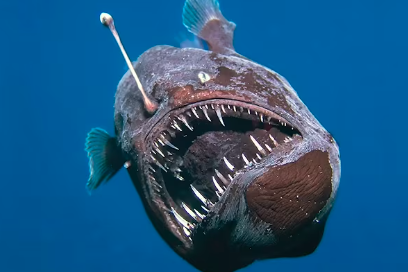
The deep-sea anglerfish is a prime example of how creatures in the abyss have evolved to survive in one of the most extreme environments on Earth. Known for its bizarre, otherworldly appearance, the anglerfish uses a bioluminescent lure on its head to attract prey in the dark, pitch-black waters of the deep ocean. The lure is a modified dorsal fin, which contains light-producing bacteria that glow in the dark, according to ScienceDaily. This eerie light attracts curious prey, such as smaller fish and invertebrates, which swim too close and are then ensnared by the anglerfish’s sharp teeth. The anglerfish’s mouth is large enough to swallow prey that is almost as big as itself, making it a formidable predator in the deep. Despite its fearsome reputation, the anglerfish is not aggressive toward larger animals, including humans.
The anglerfish is also unique in its reproductive strategy. In some species, the males are much smaller than the females, and they fuse with the females’ bodies, becoming little more than a pair of gonads that provide sperm when needed. This unusual mating method is a result of the difficulty in finding a mate in the vast, dark ocean. For the anglerfish, survival in the abyss means relying on both their predatory adaptations and their ability to reproduce efficiently in an environment where encounters with other creatures are rare. The bioluminescence that helps attract prey can also serve as a deterrent to potential predators, warning them of the anglerfish’s sharp teeth and predatory nature. The deep-sea anglerfish is a true master of survival, using a combination of lures and stealth to dominate its environment.
5. The Giant Isopod
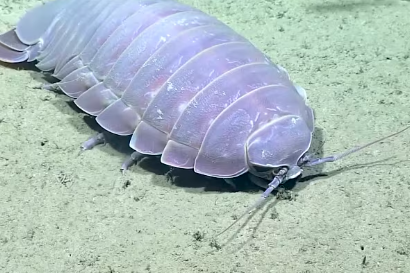
The giant isopod is one of the most unsettling creatures found in the deep ocean. Resembling a massive, armored insect, these creatures can grow up to 2.5 feet long, with hard, segmented exoskeletons that protect them from the harsh conditions of the deep sea. Giant isopods are scavengers, feeding on the carcasses of dead animals that sink to the ocean floor. They are often found at depths of over 500 meters, where food is scarce and competition is fierce, according to Wikipedia. The giant isopod’s ability to survive in these harsh conditions is thanks to its slow metabolism, which allows it to go for extended periods without food. When they do find food, they can feast on it for days, sometimes consuming up to 80% of their body weight in a single meal.
Despite their formidable appearance, giant isopods are relatively slow-moving creatures. They use their segmented legs to crawl across the ocean floor, where they search for food. Their large compound eyes are adapted to the low-light conditions of the deep ocean, allowing them to spot food and potential threats. The giant isopod’s hard exoskeleton is not only a defensive feature but also helps prevent water loss, a critical adaptation for life at great depths. These creatures are not just survivors; they are an essential part of the ocean’s ecosystem, helping to break down organic matter and recycle nutrients. Their scavenging habits make them one of the few creatures in the deep that can thrive on the remains of other animals.
6. The Frilled Shark
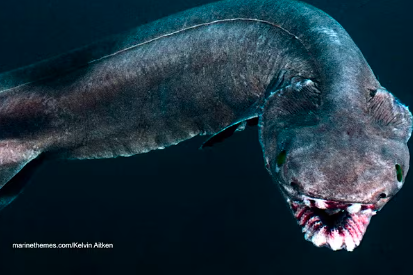
The frilled shark is one of the most bizarre and ancient-looking creatures lurking in the depths of the ocean. Often referred to as a “living fossil,” this deep-sea predator has remained largely unchanged for millions of years. Unlike typical sharks, the frilled shark has an elongated, eel-like body that allows it to move with a serpentine motion. Its mouth is filled with rows of backward-facing, needle-like teeth, making escape nearly impossible for any prey that gets caught. The frilled shark primarily feeds on squid and deep-sea fish, using its incredible flexibility to lunge forward and snatch unsuspecting prey. Unlike many sharks that rely on powerful bursts of speed, the frilled shark is more of an ambush predator. It patiently drifts through the deep, waiting for the right moment to strike with its lightning-fast attack. Scientists believe it uses a suction mechanism to help capture prey, creating a vacuum that pulls fish and squid directly into its mouth.
Frilled sharks are rarely seen by humans because they inhabit depths of around 500 to 4,200 feet. Most specimens have been discovered accidentally when caught in fishing nets or washed up on shore. Their long, gill slits, which extend across the throat, give them a “frilled” appearance, contributing to their eerie, prehistoric look. Because they live in extreme environments, very little is known about their behavior and reproduction. Scientists speculate that they have a slow reproductive cycle, meaning they give birth to only a few offspring at a time. This makes them particularly vulnerable to environmental changes and human activities like deep-sea fishing. Despite their terrifying appearance, frilled sharks pose no threat to humans. They are simply relics from an ancient time, surviving in the dark, cold waters of the abyss, a reminder of the ocean’s deep evolutionary history.
7. The Japanese Spider Crab
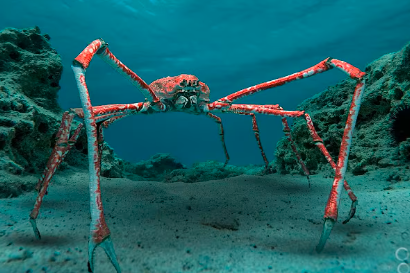
The Japanese spider crab is one of the largest arthropods in the world, with a leg span that can reach up to 12 feet. Despite their frightening appearance, these giant crustaceans are relatively gentle scavengers, feeding on dead fish, mollusks, and plant matter found on the ocean floor. Their long, spindly legs allow them to cover large distances as they search for food. The Japanese spider crab’s body is covered in spiky protrusions, which help them blend into their surroundings and avoid predators. Unlike most crabs, which rely on speed to escape danger, the Japanese spider crab uses camouflage as its primary defense. Some individuals have even been observed decorating their shells with sea sponges and debris to better blend in with the seafloor.
These crabs can be found at depths ranging from 150 to 2,000 feet, often preferring the cold waters near the Japanese coastline. Despite their large size, they are not aggressive creatures. Instead, they rely on their hard shells and ability to hide to protect themselves from predators like octopuses and large fish. During the breeding season, they migrate to shallower waters, where females lay thousands of eggs. Once hatched, the larvae drift in the ocean currents until they grow large enough to settle on the seabed. Because they grow slowly and have a long lifespan of up to 100 years, Japanese spider crabs are highly susceptible to overfishing. Their sheer size and strange appearance make them one of the most fascinating deep-sea giants, proving that even crustaceans can be enormous in the depths of the ocean.
8. The Goblin Shark
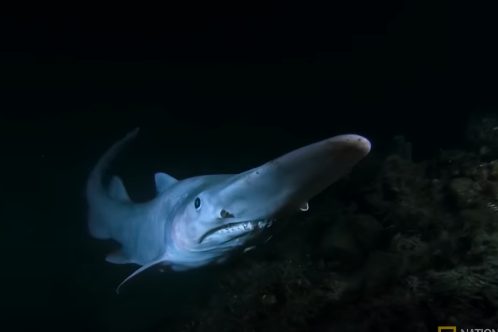
The goblin shark is one of the most alien-looking creatures in the deep sea. With its long, protruding snout and extendable, razor-sharp jaws, it looks like something out of a horror movie. Unlike most sharks, which have sleek and streamlined bodies, the goblin shark appears almost sluggish, with pinkish, flabby skin and small fins. However, what it lacks in speed, it makes up for with its terrifying ambush tactics. When hunting, the goblin shark uses special sensory organs in its snout to detect the electric signals of prey. Once it gets close, its jaws shoot forward at lightning speed, snatching up unsuspecting fish, squid, and crustaceans. This ability, known as “slingshot feeding,” allows it to catch prey even if it is slightly out of reach. The goblin shark’s teeth are needle-like and perfectly designed to pierce through soft-bodied creatures, ensuring that nothing escapes its grasp.
Goblin sharks are rarely seen by humans because they live at depths of 3,000 to 4,300 feet, far below the reach of most divers and submarines. Most of what we know about them comes from specimens accidentally caught by deep-sea fishing vessels. Unlike other sharks, which rely on powerful swimming muscles, the goblin shark has a weak, almost gelatinous body that helps it remain neutrally buoyant in the deep sea. Scientists believe that, rather than chasing prey, it simply drifts through the water, waiting for the perfect moment to strike. This unique adaptation allows it to survive in an environment where food is scarce. Despite its terrifying appearance, the goblin shark poses no threat to humans. Its sluggish movements and deep-sea habitat mean it rarely, if ever, encounters people. However, its bizarre looks and unusual feeding mechanism make it one of the strangest deep-sea giants ever discovered.
9. The Barrel-Eye Fish
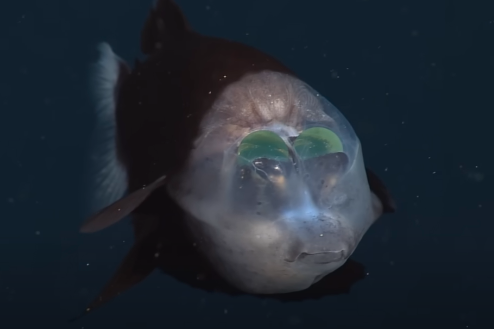
The barrel-eye fish is one of the most surreal creatures found in the deep sea. Unlike any other fish, it has a transparent, dome-shaped head that allows scientists to see its internal organs and brain. This adaptation gives it a distinct advantage in the abyss, where light is scarce, and predators lurk in the darkness. Inside its transparent head are highly sensitive eyes that can rotate upward to look for prey. These eyes are specialized to detect even the faintest glimmers of light, which is crucial for survival in the deep ocean. The barrel-eye fish primarily feeds on small jellyfish and plankton, using its incredible vision to spot food drifting in the water column. Its unique, barrel-shaped eyes give it an ultra-wide field of view, allowing it to track movement from multiple angles.
One of the most fascinating aspects of the barrel-eye fish is its ability to remain almost motionless in the water. Using its large, flat fins, it hovers in place, waiting for the perfect opportunity to strike at its prey. Because it lives at depths of 2,000 to 2,600 feet, very little is known about its behavior. However, deep-sea expeditions have captured rare footage of this strange fish in its natural habitat. Scientists believe that its transparent head helps protect its sensitive eyes from the stinging tentacles of jellyfish, which make up a significant portion of its diet. The barrel-eye fish’s eerie appearance and fascinating adaptations make it one of the most remarkable deep-sea giants, proving that the ocean depths are home to some truly extraordinary creatures.
10. The Vampire Squid
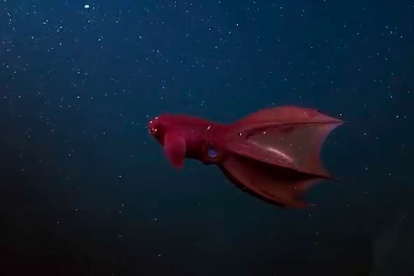
The vampire squid is one of the most fascinating and misunderstood creatures of the deep ocean. Despite its ominous name, it is not a true squid, nor is it a true octopus—it belongs to its own unique order, known as Vampyromorphida. This deep-sea cephalopod gets its name from its dark, reddish body and the webbing between its arms, which resembles a vampire’s cape. Unlike other squids and octopuses, the vampire squid does not use ink to evade predators. Instead, it produces a bioluminescent mucus that confuses attackers, allowing it to escape unnoticed. This adaptation is crucial in the pitch-black depths of the ocean, where survival depends on creative ways to avoid being eaten. The vampire squid’s body is covered in photophores, which allow it to glow in the dark, making it one of the few deep-sea creatures that can control its own light.
Unlike other squid species, which actively hunt for prey, the vampire squid is a passive feeder. It survives on “marine snow”—a combination of dead organic material, plankton, and microscopic organisms that slowly drift down from the upper layers of the ocean. Using its sticky filaments, it collects tiny particles from the water, rolling them into balls before consuming them. Because of its slow-moving nature, the vampire squid has very few natural predators, though deep-sea fish and larger squids may occasionally hunt it. Despite its eerie appearance, the vampire squid is a harmless and gentle creature that plays a vital role in the ocean’s ecosystem. Its ability to thrive in oxygen-deprived waters makes it one of the most resilient deep-sea giants, proving that even in the most extreme environments, life finds a way to adapt.
11. The Deep-Sea Dragonfish
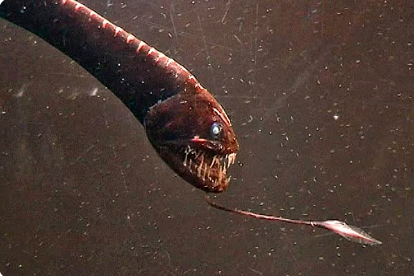
The deep-sea dragonfish is one of the most fearsome predators lurking in the abyss. With its long, eel-like body, needle-sharp teeth, and bioluminescent organs, it is perfectly adapted for hunting in complete darkness. This terrifying fish lives at depths of 1,500 to 6,000 feet, where sunlight never reaches. Unlike most fish, which rely on their eyesight to locate prey, the dragonfish uses specialized light-producing organs called photophores to lure unsuspecting victims. These photophores line its body and can be turned on and off at will, allowing the dragonfish to create a hypnotic glow that attracts smaller fish. Once a prey item gets too close, the dragonfish’s oversized jaw snaps shut, trapping the unfortunate creature in its razor-lined mouth.
One of the most fascinating aspects of the dragonfish is its ability to produce red light, which is almost invisible to most deep-sea creatures. This gives it a significant hunting advantage, as it can see its prey without being detected. Unlike many deep-sea fish that have small, underdeveloped eyes, the dragonfish has large, well-adapted eyes that allow it to detect even the faintest movements in the water. It is also capable of surviving in extreme pressure conditions that would crush most surface-dwelling fish. Despite its monstrous appearance, the deep-sea dragonfish is a relatively small creature, usually growing no longer than a foot. However, its fearsome adaptations make it one of the most efficient hunters in the deep ocean, proving that even the darkest depths are teeming with formidable predators.
12. The Dumbo Octopus
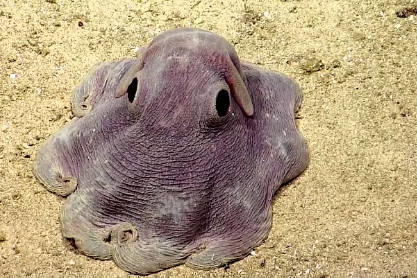
Among the deep-sea giants, the dumbo octopus stands out for its almost cartoonish appearance. Named after the Disney character Dumbo, this octopus has large, ear-like fins that it uses to propel itself through the water. Unlike many of its deep-sea relatives, the dumbo octopus does not have an ink sac, as it has very few natural predators in its extreme environment. These creatures live at depths of up to 13,000 feet, making them one of the deepest-dwelling octopus species in the world. Despite their harsh habitat, dumbo octopuses are surprisingly graceful, using their ear-like fins to glide through the water with ease. Their bodies are soft and gelatinous, allowing them to withstand the immense pressure of the deep sea.
Unlike other octopuses, which are known for their intelligence and problem-solving skills, dumbo octopuses have a more passive approach to life. They do not hunt aggressively but instead drift along the ocean floor, using their tentacles to capture small crustaceans and worms. When they find food, they envelop it in their web-like arms before consuming it whole. Because of their deep-sea habitat, encounters with dumbo octopuses are incredibly rare, and much of what we know about them comes from footage captured by remotely operated vehicles (ROVs). These adorable creatures serve as a reminder that not all deep-sea giants are fearsome predators—some are simply gentle wanderers of the abyss.
13. The Greenland Shark
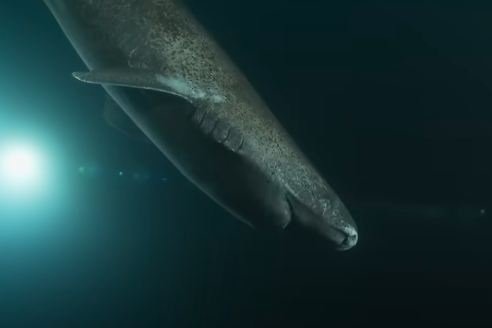
The Greenland shark is one of the most mysterious and longest-living creatures in the deep sea. These massive sharks can grow up to 24 feet long and weigh over 2,000 pounds, making them one of the largest predatory fish in the ocean. What sets them apart from other sharks is their astonishing lifespan—Greenland sharks are estimated to live for over 400 years, making them the longest-living vertebrates on Earth. Scientists have determined their age by analyzing the proteins in their eye lenses, which accumulate changes over time. Some individuals swimming in the depths today may have been alive during the age of Shakespeare, making them true relics of the past. Unlike their faster shark relatives, Greenland sharks are incredibly slow-moving, earning them the nickname “sleeper sharks.” They rely on stealth rather than speed to catch prey, often ambushing fish, squid, and even seals.
Greenland sharks are also known to scavenge on carcasses that sink to the ocean floor, making them an essential part of the deep-sea ecosystem. Because they live at depths of 600 to 3,900 feet, they are rarely encountered by humans, and much about their behavior remains a mystery. One of their most unusual traits is their poor eyesight, caused by parasites that attach to their eyes, rendering them nearly blind. However, this does not seem to hinder their hunting abilities, as they rely on their sense of smell and slow but efficient movements to locate food. Due to their extreme longevity and deep-sea lifestyle, Greenland sharks have very few natural predators. They are living time capsules of the ocean, surviving in the abyss for centuries, silently roaming the deep in near-total darkness.


